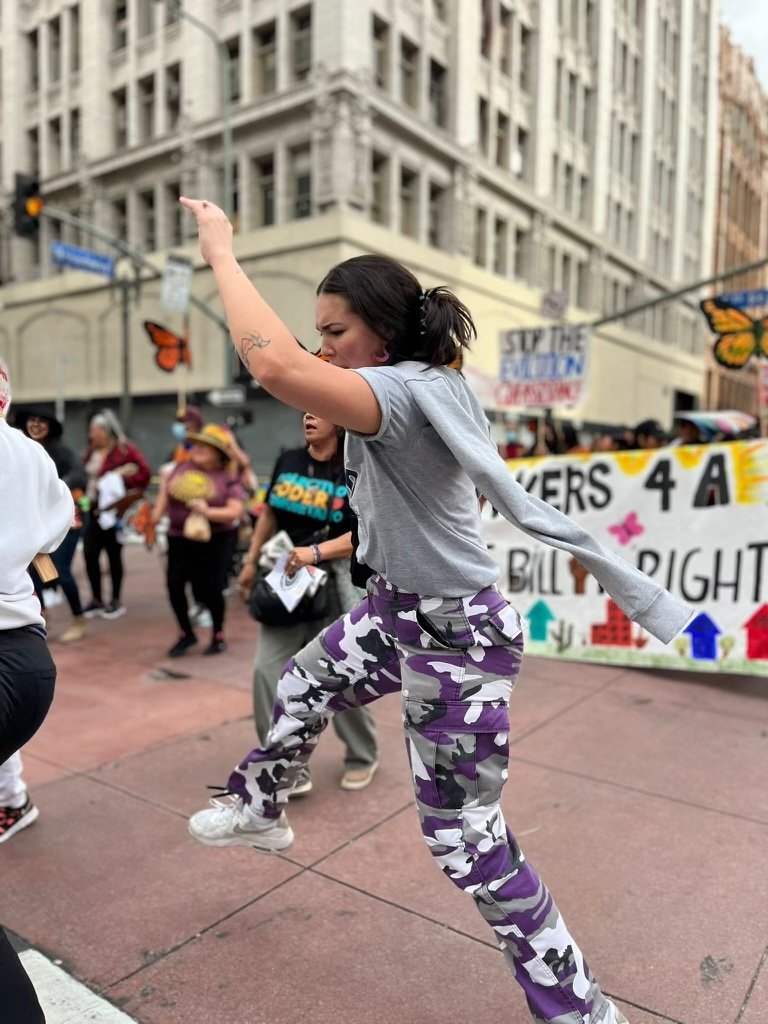The Power of Art as Social Action
As Carol Hanisch said, “the personal is political” and art is personal. For CONTRA-TIEMPO, our artistic work represents/tells the stories of persons impacted by patriarchy, systemic racism, and white supremacy. When personal stories are shared socially through dance, music, theater, visual art, poetry we are exercising our personal and social power as a connected community.
First, let’s break down the phrase “Power of Art as Social Action”
Power is defined as the ability to do something or act in a particular way or the capacity to direct or influence the behavior of others or the course of events. CONTRA-TIEMPO defines power in multiple ways. Access to resources can define how much power one has. This includes financial resources, placement in positions of influence within decision-making bodies, and ability to reach a wide audience and influence public opinion. In our society and world, it is assumed that the majority of power is held by institutions and the elite, however, we believe that individuals have enormous power and agency to effect change. Each person’s potential to contribute to change through their actions, choices, and voices, amplifies the power of the collective.
Social Action refers to individual or group behavior aiming to create positive change within a community or society. It can also refer to actions that individuals take while considering the reaction of others. In CONTRA-TIEMPO, we value and teach deliberate and purposeful action while also considering the impact that our actions may have on individuals and communities.
Art is such a vast genre of being and creating. It is a diverse range of human activities and products involving creative or imaginative talent, generally expressive of technical proficiency, beauty, emotional power, or conceptual ideas. Art conveys emotions, ideas, stories, or experiences. Art influences culture and vice versa - understanding the context in which art is created and viewed and experienced is crucial for interpreting its meaning and significance
… Here’s a look at the power of art and its ability to influence societal change.
The Power of ArT
The Power of Art as Social Action is the capacity for each of us to be profoundly changed by encounters with art and artists whose work contextualizes the traumas and triumphs of human resistance and resilience. Art in all its forms is powerful in so many ways. Paintings, dancing, singing, writing, and more all hold incredible strength and meaning. It can bring us together, give us the tools to express ourselves, and promote healing. We believe that art is a weapon, a megaphone, a bridge that connects us to our shared humanity and empowers us to challenge the status quo. The healing power of art is one of its amazing benefits, from relieving stress and supporting cognitive health to working through trauma and mental illness.
From the pulsating rhythms of our Afro-Latine roots to the contemporary expressions of our realities, dance becomes a language of resistance. Every turn, every step, every beat tells a story - a story of struggle, resilience, and the unwavering pursuit of a just world.
This is done through artistic activism. Tate explains that “activist art is about empowering individuals and communities and is generally situated in the public arena with artists working closely with a community to generate the art.” Its purpose is to intertwine art and activism in a way that uses creativity to promote social change.
The concept of art as activism works extremely well when considering these qualities of art:
Art can provoke feeling and inspire action. Instead of just telling facts, art tells stories. It tugs at our emotions and spurs us to do something. We are transformed by stories of healing, and renewed by engaging in creative practices.
Art creates community. We cannot exist outside of the communities that we inhabit. Art cannot exist apart from community. The experiences, cultural creations, and “we-stories” of our communities are the inspiration and motivation for our art making. And it is our duty as artists to share our creative power to help grow the creative and social power of our communities.
Art is accessible. Anyone can create, and anyone can enjoy! The lack of barriers to entry invites the voice of marginalized groups. From the kindergarten class to the corporate professionals to the abuelita, every person can participate in our programs. These ancestral technologies are not exclusive to the professional or the able-bodied. But they are a tool to connect us.
Art is everywhere. Causes can be championed online, in a gallery, on a stage, in the park—even on the side of a water bottle. Black and Brown people know how to get down and practice joy no matter what, no matter where, no matter how. When they outlawed drums, we grabbed our pots, when they said the speakers were too loud, we freestyled to the rhythm of our claps. The get-down can happen anywhere!
Examples of Art Activism
The idea of art as social action is not new. Artists have used their work to inspire change throughout history, and continue to do so today. Artwork, performance work, and writing or speaking can be used to advocate for any cause! Artists champion climate change with Earth Day art and use human rights art to create social change. Art as Social Action could be defined as ritualizing communal agreements for change.
For members CONTRA-TIEMPO life and art are inseparable. The lives of the artists inform the artwork and artmaking, and the artworks inform the lives of the artists. They are performing artist who dedicate themselves to the art of teaching and skill of community building. Through school programs, community-based Choreo Labs, open and public Sabor sessions, Futuro Intensives and teaching residencies CONTRA-TIEMPO breaks down elitist barriers to the performing arts. We practice joy, spread information, and alchemize our rage into action, love, and connection.
After the murders of Ahmad Arbery, Breonna Taylor and George Floyd dance, song, and visual art was used to mourn, build resistance, and speak a truth that is often silenced about being Black in America. Visual arts, music, and dance are vital within communities as a way to connect and protest against the degradation and exploitation of Black culture and to demand the end of repeated killings of their descendants by those who were sworn to protect and serve them.
Through CONTRA-TIEMPO, we use our physically intense and politically astute performance work to move audiences to imagine what’s possible. We create communities where all people are awakened to a sense of themselves as artists and social change agents who move through the world with compassion and confidence.
As a Los Angeles-based activist dance company, we wield the power of art to influence social change, live out our values, and teach others to engage in art activism! Explore our engagement offerings, upcoming events and performances, and virtual engagements for a taste of what we bring to the Los Angeles community and beyond! Join our familia and connect with us, or support our movement by purchasing from our shop or donating today!
Bibliography
Armstrong, J. (2021, September 17). The healing power of art: Magazine: MoMA. The Museum of Modern Art. Retrieved July 29, 2022, from https://www.moma.org/magazine/articles/629
Artists for the Earth. Earth Day. (n.d.). Retrieved July 29, 2022, from https://www.earthday.org/campaign/artists-for-the-earth/
The Center for Artistic Activism. (2018, April 9). Why artistic activism? The Center for Artistic Activism. Retrieved July 29, 2022, from https://c4aa.org/2018/04/why-artistic-activism
Eliasson, O. (2016, January 18). Why art has the power to change the world. World Economic Forum. Retrieved July 29, 2022, from https://www.weforum.org/agenda/2016/01/why-art-has-the-power-to-change-the-world/
Force, T. L., Lescaze, Z., & Hass, N. (2020, October 15). The 25 most influential works of American protest art since World War II. The New York Times. Retrieved July 29, 2022, from https://www.nytimes.com/2020/10/15/t-magazine/most-influential-protest-art.html
The healing power of art. Harvard Health. (2017, July 1). Retrieved July 29, 2022, from https://www.health.harvard.edu/mental-health/the-healing-power-of-art
Sachant, P. J., & Tekippe, R. (n.d.). Introduction to art: Design, context, and meaning: 9. art and power. "9. Art and Power" in "Introduction to Art: Design, Context, and Meaning" on OpenALG. Retrieved July 29, 2022, from https://alg.manifoldapp.org/read/introduction-to-art-design-context-and-meaning/section/54129c96-ca5a-4108-832b-9e3180e85cc8
Tate. (n.d.). Activist art. Tate. Retrieved July 29, 2022, from https://www.tate.org.uk/art/art-terms/a/activist-art
https://www.carolhanisch.org/CHwritings/PIP.html





